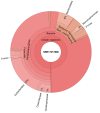Enhancing Gas Fermentation Efficiency via Bioaugmentation with Megasphaera sueciensis and Clostridium carboxidivorans
- PMID: 40428089
- PMCID: PMC12109107
- DOI: 10.3390/bioengineering12050470
Enhancing Gas Fermentation Efficiency via Bioaugmentation with Megasphaera sueciensis and Clostridium carboxidivorans
Abstract
Gas fermentation aims to fix CO2 into higher-value compounds, such as short or medium-chain fatty acids or alcohols. In this context, the use of mixed microbial consortia presents numerous advantages, including increased resilience and adaptability. The current study aimed to improve the performance of an enriched mixed microbial population via bioaugmentation with Megasphaera sueciensis and Clostridium carboxidivorans to improve the metabolite spectrum. The initial fermentation in trickle-bed reactors mainly yielded acetate, a low-value compound. Introducing M. sueciensis, which converts acetate into higher-chain fatty acids, shifted production toward butyrate (up to 3.2 g/L) and caproate (1.1 g/L). The presence of M. sueciensis was maintained even after several media swaps, showing its ability to establish itself as a permanent part of the microbial community. Metataxonomic analysis confirmed the successful integration of M. sueciensis into the mixed culture, with it becoming a dominant member of the Veillonellaceae family. In contrast, bioaugmentation with C. carboxidivorans was unsuccessful. Although this strain is known for producing alcohols, such as butanol and hexanol, it did not significantly enhance alcohol production, as attempts to establish it within the microbial consortium were unsuccessful. Despite these mixed results, bioaugmentation with complementary microbial capabilities remains a promising strategy to improve gas fermentation efficiency. This approach may enhance the economic feasibility of industrial-scale renewable chemical production.
Keywords: Clostridium carboxidivorans; Megasphaera sueciensis; bioaugmentation; gas fermentation; medium-chain volatile fatty acids; mixed microbial culture.
Conflict of interest statement
The authors declare no conflicts of interest. The funders had no role in the design of the study; in the collection, analyses, or interpretation of data; in the writing of the manuscript; or in the decision to publish the results.
Figures










References
-
- Rocha J., Oliveira S., Viana C.M., Ribeiro A.I. Climate Change and Its Impacts on Health, Environment and Economy. In: Prata J.C., Ribeiro A.I., Rocha-Santos T., editors. One Health. Academic Press; London, UK: 2022. pp. 253–279.
-
- Nawaz T., Nelson D., Fahad S., Saud S., Aaqil M., Adnan M., Saleem A., Bibi M., Joshi N., Rahman T.U., et al. Impact of Elevated CO2 and Temperature on Overall Agricultural Productivity. In: Fahad S., Adnan M., Munir I., Lal R., Nawaz T., Saud S., editors. Challenges and Solutions of Climate Impact on Agriculture. Academic Press; London, UK: 2025. pp. 163–202.
-
- Oumer A.N., Hasan M.M., Tesfamichael Baheta A., Mamat R., Abdullah A.A. Bio-Based Liquid Fuels as a Source of Renewable Energy: A Review. Renew. Sustain. Energy Rev. 2018;88:82–98. doi: 10.1016/j.rser.2018.02.022. - DOI
Grants and funding
LinkOut - more resources
Full Text Sources

